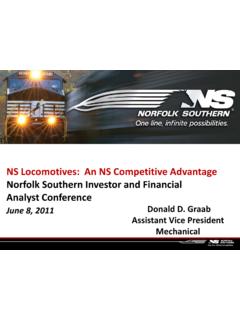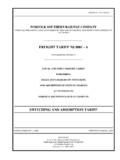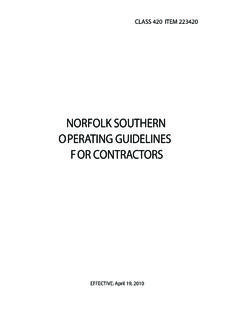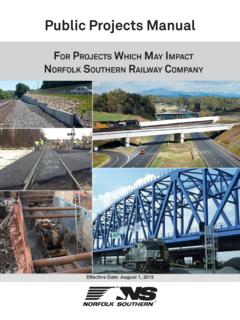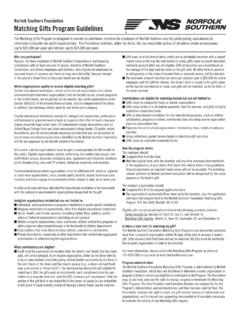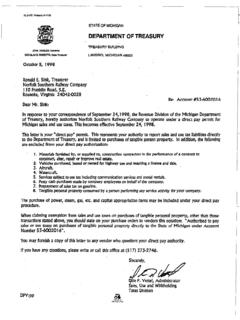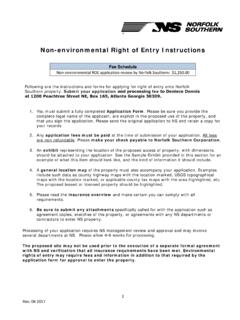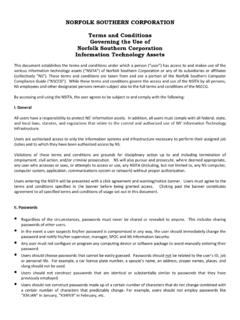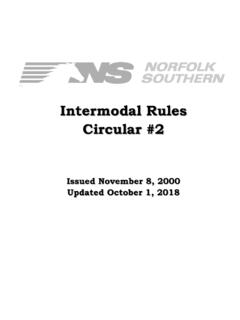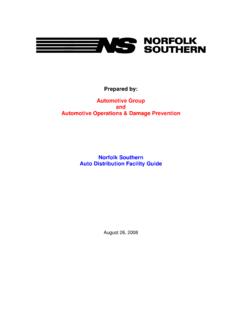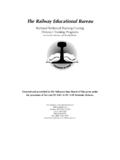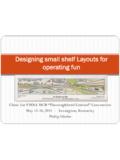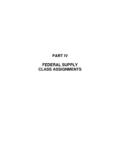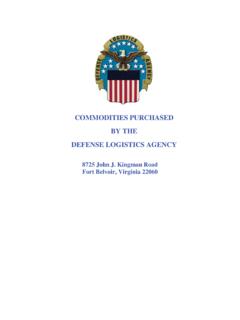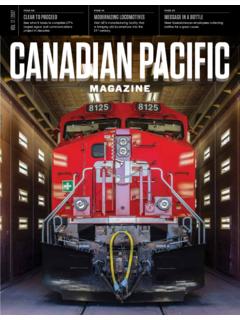Transcription of November-December 2009 Volume 1, Issue 6
1 V o l u m e 1 , I s s u e 6 | N o v e m b e r - D e c e m b e r 2 0 0 9 Research and Tests Drawing on the leading edge of rail technologyNov/Dec 091 RESEARCH AND TESTS HELPS NS IMPROVE SAFETY5wHERE THE wILD THINGS ARE7NS 999: HORSE OF A DIFFERENT COLOR10NS POLICE AND THE G-20 MEETING12bENEFITS OF SOCIAL MEDIA AND GUIDELINES14 TRAINYARD TECH KEEPS THE CARS ROLLING16 SPIRIT AwARD wINNERS17 THEFUTURENEEDS RECEIVES AwARD FROM RTACALENDARS AVAILAbLEOn the leading edge1 Norfolk Southern CorporationResearch and tests helps NS improve safety, cut costs, get greenerA sign out side Bob Blank s office sums up the mission of Norfolk Southern s research and tests group: Be the most respected and responsive industry resource for quality technical services and innovative developments.
2 It s a straightforward statement, suggesting specialized knowledge, out-of-the-box thinking, and pride in work. It barely does justice, however, to the contributions this team of engineering whizzes makes to NS and its railway on the top floor of a red-brick NS office building in Roanoke, the employees in research and tests play a role in virtually every major initiative the railroad has , the director, recently notched his 36th year with the group, known as R&T. Research and tests has evolved over the last few years, said Blank, a mechanical engineer. For many years we did a lot of fire fighting an incident happened, and we tried to figure out why. We ve migrated into bigger, higher profile strategic projects. Now, R&T is an industry leader in evaluating green technology that is changing the way NS does researchers helped NS pioneer such technologies as top-of-rail friction modification, which reduces rail wear and conserves diesel fuel, and LEADER, a new computer-based train handling system that reduces fuel use and improves the past two years, the group has guided NS development of an electric switcher locomotive, a battery-powered prototype that makes use of dynamic braking to charge its battery energy storage system a first for the rail batteries, R&T assesses biofuels, natural gas, liquefied coal, and electricity as alternatives to power locomotives.
3 In August, Hayden Newell, R&T s manager innovative research, attended a national conference on algae a potential biofuel source. In this job, you feel like you re breaking ground almost every day on some kind of technology or advancement, said Newell, a 37-year R&T veteran. Among North America s Class 1 railroads, NS has the most aggressive research and tests effort for technology development, according to Gerhard Thelen, who oversees the group as vice president operations and planning support. We have a lot of in-house institutional knowledge, Thelen said, and that s what it takes to run this business successfully in the long run. n Top: Research and tests engineers work with computer models to examine railroad operations, including one called VAMPIRE, which can simulate a rail car s movement over track and help NS analyze and prevent accidents and Bob Blank, a mechanical engineer and 36-year veteran of R&T, is director of the Facing page: R&T conducts a variety of tests on car knuckles and couplings, such as this one, to gauge their strength and endurance.
4 We ve migrated into bigger, higher profile strategic projects. Bob Blank, director research & tests2 BizNS Nov/Dec 2009 Adding value to the railroadMost of the 27 employees in R&T have engineering or technical backgrounds. The group is heavy in mechanical and material engineers, also called metallurgists, and there are chemical and civil engineers. Because track is NS No. 1 maintenance and capital expense, metallurgists are key. We re concentrating on how to extend the life of rail and the time between maintenance cycles, such as surfacing or cross tie work, Thelen , the group s range of expertise is joining R&T 26 years ago, Jack Hughes, senior research engineer, did drug analysis and trace evidence work for the Virginia Bureau of Forensic Science.
5 Hughes, who has a chemistry degree, currently is evaluating preservative treatments for wood cross ties. He s also involved in weed control, a multi-million dollar program at NS to keep trackside rights-of-way clear of Conn, a research engineer, once worked as an analytical chemist in the petroleum and industrial chemical industries. Conn is R&T s lead researcher in top-of-rail friction modification, a technology NS has advanced for the industry. We ve got people who like to break things. Bob Blank, director research & testsn Top left: R&T engineers use electron scanning microscopes to analyze everything from chemical makeup of rail equipment to defects in tools, rail, and track Top center: A hydraulic machine, capable of producing 600,000 pounds of pressure, is used to run fatigue tests on car coupler knuckles.
6 A 45-minute cycle with maximum loads of 300,000 pounds is equivalent to 1,000 miles of severe rail Top right: R&T does precision, computer-controlled testing to evaluate railroad equipment. Shown are cables that connect various servo-hydraulic testing machines to a central computer, enabling R&T engineers to control and monitor up to 11 different testing stations simultaneously while collecting desired Above: R&T is interested in the strength and endurance of coupler parts, including knuckle pins and draft keys, pictured here, which get a workout during knuckle fatigue Southern CorporationThe idea behind top-of-rail is to reduce the lateral force of rail cars as they run over curved sections of track. A water-soluble material similar to toothpaste is dispensed on the rail running surface as a train passes, easing friction between wheels and rail.
7 The result: reduced rail wear and locomotive fuel savings. Conn now is doing research with vendors on different lubricant materials and equipment to improve the system. Working with a vendor, Scott Keegan, R&T manager project engineering, helped develop the industry s initial application of LEADER on coal trains running between Roanoke and a power plant near Winston-Salem, LEADER, which stands for Locomotive Engineer Assist Display and Event Recorder, has an on-board computer that prompts locomotive engineers with real-time information about a train s operating conditions, including optimum speed for maximum fuel savings. The challenge, Keegan said, is to give enough information at critical points to ensure that an engineer makes the right decision.
8 R&T is using LEADER to help NS find other ways to save money and operate more efficiently. One recent project identified optimum speed and throttle settings for bulk commodity trains, producing fuel savings of up to 20 percent per get to break things Much of R&T s work occurs at two laboratory buildings in Roanoke. On a press machine that generates enough pressure to snap rail in half, employees conduct slow bend tests to measure the quality and strength of rail a hydraulic machine, R&T runs fatigue tests on car coupling knuckles. A 45-minute workout with maximum loads of 300,000 pounds of pressure is equal to 1,000 miles of severe railroad wear and can push knuckles to the breaking point. We ve got people who like to break things, Blank says, R&T engineers want to know why equipment breaks.
9 In search of causes, they peer through electron scanning microscopes, use ultrasonic scopes, and perform spectrographic chemical analyses on everything from failed rail welds to broken switch clip NS mechanical shop employees reported repeated chisel failures, R&T discovered through testing that a supplier had switched to a different material to make the tool, said Tim Ward, R&T manager material of the engineers work with sophisticated computer models, such as the VAMPIRE for Vehicle Dynamic Modeling Package in a Railway Environment. The models help the railroad analyze and prevent such things as derailments. We can simulate how a rail car reacts to rolling over a certain piece of track, said research engineer Walter Rosenberger. The group also monitors data from track wayside sensors that alert operations departments of potential problems, from imbalanced rail cars to faulty wheels.
10 They also evaluate employee gear, such as best footwear in icy conditions and the most durable train addition to all that, R&T operates NS 32, a research rail car that tests the pulling power of locomotives and freight car dynamics, and two sets of track geometry cars equipped with sensors that detect defects in rail, cross ties, and other track infrastructure. Typically, the cars collect data on about 40,000 track miles every is working with other NS departments to create a computer-based track infrastructure Nov/Dec 2009 The goal is to use this data for long-term trending and forecasting, and to do a more sophisticated analysis of where NS maintenance and capital dollars should be spent, said Russ McDaniel, R&T director process database will include information from such things as rail grinding, which smoothes out rail surface defects, and ultrasonic testing that detects internal flaws in rail.
